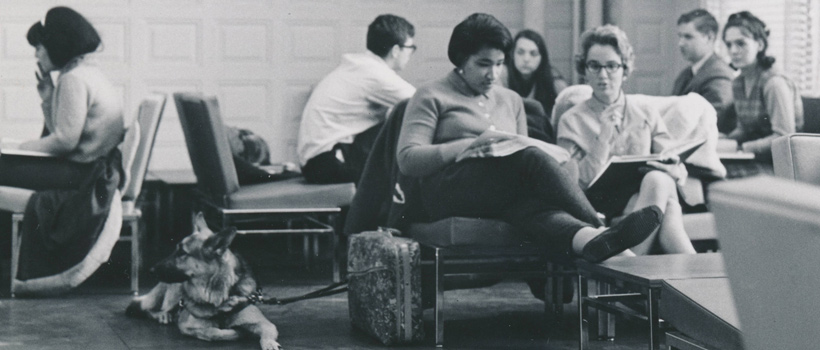- Home
- Academics
- Student Equity, Access & Success
- Ross Center for Disability Services
- Who Was The Ross Center Founder
Menu
- Majors & Programs
- Advising
- Colleges & Schools
- Student Equity, Access & Success
- Global Programs
- Study Abroad
- Fellowships
- Provost's Office
Who Was the Ross Center Founder?

Lillian Semper Ross, pictured above with her feet propped up, was a student at UMass Boston in the late 1960s, decades before the Americans with Disabilities Act (ADA) became law. Before that act, there was nothing to prohibit discrimination against individuals with disabilities in all areas of public life, including jobs, schools, transportation, and all public and private places that are open to the general public.
She had lost her vision during her adolescence and was totally blind from optic atrophy. While she had a trained Seeing Eye dog, she was often refused service because the dog was not allowed into restaurants, hotels, or even buses.
After she graduated, she wanted to start an office for blind students, something that was unheard of at the time. She knew how to get around the agencies, how to get what she needed, how to get the money for readers, how to get scholarships, and how to use the resources, and she wanted to put this knowledge to use for other people. Around 1970, she wrote a grant to the university to start the Resource and Counseling Center for Blind Students, which very quickly got changed to the Resource and Counseling Center for Handicapped Students.
Funded by the university through Student Support Services, the center initially served about six blind students, but the population grew steadily and began serving a wider range of disabilities. Lillian remained engaged with the Center even after she married and had a child, but she eventually left in 1973 to take a part time job at the Massachusetts Commission for the Blind.
Lillian Semper Ross left a legacy of a strong community of individuals who helped each other through a lot of tough times. A lot of leaders grew out of those early days, and many went on to serious involvement in disability rights in Massachusetts and in other parts of the country.